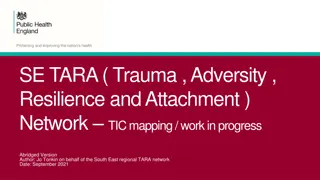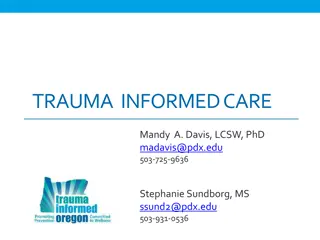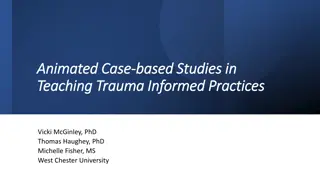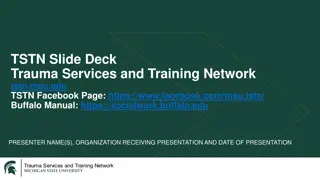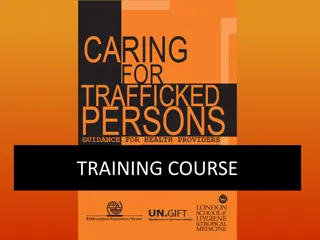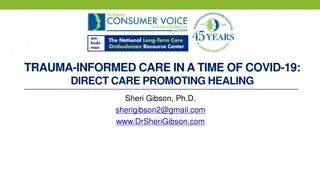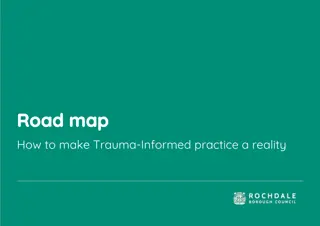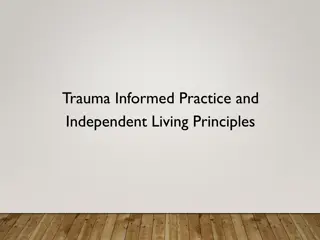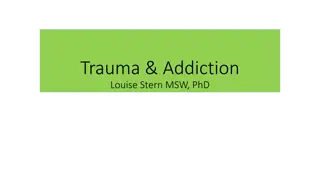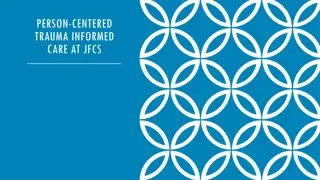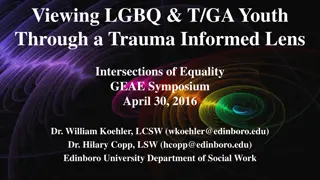Understanding Trauma-Informed Care Training
Trauma-Informed Care Training involves understanding child traumatic stress, recognizing the effects of trauma on child development, behaviors, and functioning, as well as preventing and coping with Compassion Fatigue. It emphasizes creating safety for both providers and survivors and empowering survivors to rebuild a sense of control and empowerment. This training delves into what makes an event traumatic, child traumatic stress, and the different types of trauma that can impact individuals, especially children.
Uploaded on Sep 13, 2024 | 0 Views
Download Presentation

Please find below an Image/Link to download the presentation.
The content on the website is provided AS IS for your information and personal use only. It may not be sold, licensed, or shared on other websites without obtaining consent from the author. Download presentation by click this link. If you encounter any issues during the download, it is possible that the publisher has removed the file from their server.
E N D
Presentation Transcript
Learning Objectives Define Trauma-Informed Care Understand Child Traumatic Stress Understand the effects trauma has on child development, behaviors, and functioning Recognize, prevent, and cope with Compassion Fatigue Recognize that many parents Child Welfare workers encounter have also experienced trauma when they were children
What is Trauma-Informed Care? Trauma Informed Care is a strengths-based framework that is grounded in an understanding of and responsiveness to the impact of trauma that emphasizes physical, psychological, and emotional safety for both providers and survivors and, that creates opportunities for survivors to rebuild a sense of control and empowerment. ~(Hopper, Bassuk, & Olivet, 2010, pg. 82)
What Makes an Event Traumatic? Traumatic Events are: Sudden, unexpected, and extreme Usually involve physical harm or perceived life threat (research shows the perception of life threats are powerful predictors of the impact of trauma) People experience these events as out of their control Certain stages of life makes people vulnerable to the effects of trauma including childhood, teens and early twenties. ~(Tedeschi, 2011)
What is Child Traumatic Stress? Child traumatic stress is the physical and emotional response a child has to events that pose a threat to the child or someone important to them. When a child experiences trauma, the child may be unable to cope, have feelings of terror and powerlessness and experience physiological arousal they cannot control.
What is Child Traumatic Stress? (Cont d) A traumatic event can affect the way children view self, the world around them, and their future. A child who is traumatized may not be able to trust others, may not feel safe, and may have difficulty handling life changes.
Types of Trauma Acute trauma is a one-time traumatic event. Some examples of acute trauma are: An auto accident A violent event in the community, such as a shooting A natural disaster such as a flood or a hurricane A sudden loss of someone the child cares about An assault When a child experiences acute trauma, he or she may experience a range of emotions and physical reactions that are quite overwhelming.
Types of Trauma (Contd) Chronic trauma occurs when children experience multiple traumatic events. These events may be varied in circumstances. For example a child may suffer ongoing sexual abuse, be a victim of physical assault at school, and then be involved in a car accident each contributing to chronic trauma. Chronic trauma can have a cumulative effect. Subsequent traumatic events remind the child of prior trauma and can trigger emotions and thoughts related to that prior trauma.
Types of Trauma (Contd) Complex trauma refers to the impact chronic trauma has on a child s life and developing systems. A child who has complex trauma has experienced multiple traumatic events, often from early childhood and this can have a profound impact on the child s development and ability to function normally.
Most children who become involved in the child welfare system have likely had multiple exposures to trauma. Universal Precautions Approach The prevalence of trauma is so high that child welfare workers should assume that everyone they serve has a trauma history. (Hodas, 2004)
Bryces Story Hey, I m Bryce and I m 9 years old. I just came to live with my grandma because my mom s boyfriend has been hitting her and then he got really mad one day and hit me in the face and I couldn t open my eye. I miss my mom and I m worried about her-she s all I have, my dad died when I was 5 from drugs.
Bryces Story Bryce s grandmother reports that he is having nightmares and is very jumpy. He scares easily at loud noises. Bryce is sometimes withdrawn and will not talk and he has had a few anger outbursts. Bryce has experienced multiple traumatic events (chronic trauma) such as the death of his father, witnessing family violence, physical abuse by his mother s boyfriend, and separation from his primary caregiver and these events are having an impact on Bryce s functioning and sense of safety (complex trauma).
Other Sources of Stress The children we serve may also face other stresses in their life such as: Poverty Discrimination Separations from caregivers and family members Frequent placements (or moving around often) Problems at school Immigration issues
How a Child Responds to Stress and Trauma Children respond in different ways to traumatic events. What may be a traumatic event for one child, may not be for another child. The objective nature of the event and the child s subjective response determines the effect that event will have on the child.
How A Child Responds to Stress and Trauma (Cont d) Several things factor into the effect of a traumatic event for a child and should be considered when assessing that child s trauma history, for instance: The age and developmental level of the child How the child perceived the danger The role the child played in the event (victim or witness) Previous trauma the child has experienced Protective capacities of adults involved in the child s life
What Does This Mean for Child Welfare Workers? Building Trauma Informed Care Systems requires a Paradigm Shift from the Question: What is wrong with you? to What happened to you? A child s behavior may be indicative of: Coping Mechanisms Survival Techniques Resiliency Ask yourself: 1. Is what I am doing respectful and trauma-informed? 2. Am I treating others the way I want to be treated? One of the most important things we can do as providers is avoid re- traumatizing those we serve.
Effects of Trauma on Children When individuals charged with protecting and nurturing children negate protective responsibilities, the effects are manifested throughout a child s life. Children who have suffered trauma are impacted in the following areas: Attachment Physical and Psychological development
Long-Term Effects of Childhood Trauma When a traumatized child does not cope with trauma in a healthy manner, the child may be prone to: Substance abuse Mental health issues (such as depression and suicide) Promiscuity Criminal behavior
Children and PTSD Children who have experienced multiple traumatic events are often diagnosed with Post Traumatic Stress Disorder (PTSD). Key symptoms of PTSD include: The child re-experiences the trauma (typically through flashbacks and nightmares) The child will avoid stimuli associated with the trauma The child may disengage from their emotions (may lose interest in things they used to like to do) The child may have physical symptoms for no medical reason (stomach aches, headaches, etc.) The child may be more hyper vigilant (startle easily)
Trauma and the Brain Trauma often has a profound impact on the development of a child s brain, brain chemistry, and nervous system. Studies show stress hormones of traumatized children are similar to those of war veterans.
Trauma and the Brain (Contd) Children involved in the child welfare system are often diagnosed with disorders such as: Reactive Attachment Disorder Attention Deficit Hyperactivity Disorder Oppositional Defiant Disorder Bipolar Disorder Conduct Disorder Many children who receive these diagnosis have been victims of multiple traumatic events and it is important that the impact of those traumatic events is considered and evaluated when a child is being assessed for a mental health diagnosis.
Trauma and the Brain (Contd) Let s take a closer look at how trauma can impact the brain at particular developmental stages.
Trauma and the Brain (Contd) In early childhood, trauma can reduce the size of the cortex, which is responsible for complex functions such as language and memory. To the left is a CT scan of two 3-year- old children. The image on the left is that of a healthy child and represents a normal brain. The image on the right is the image of a severely neglected child. Notice the difference in size. The cortex is significantly smaller which contributes to reduced gross motor abilities and maladaptive development.
Trauma and the Brain (Contd) Trauma in early childhoodcan also impact the brain s ability to cross-talk between the hemispheres. This includes the parts of the brain that control emotions, which can affect IQ and the ability to regulate emotions. This can often lead to a child feeling fearful and unsafe.
Trauma and the Brain (Contd) In school-age children, trauma can impact the parts of the brain that are responsible for managing fears, learning, and impulse control. A school-age child who has been traumatized may display the following symptoms: Problems at school (both behavior and learning) Disrupted sleeping patterns May withdraw or become clingy Difficulty in relationships with siblings and/or peers Physical symptoms for which there is no medical reason for (aches and pains, feeling sick)
Trauma and the Brain (Contd) In adolescent children, trauma can impact the development of the prefrontal cortex, which is the part of the brain responsible for connecting behaviors and consequences, problem solving, inhibitions, and impulse control. When this part of the brain has not been fully developed, an adolescent may engage in more risk-taking behavior, make poor decisions, not perform well at school and become involved in criminal activity.
Behavioral and Developmental Effects of Trauma Take a moment to review the handout, Behavioral and Developmental Effects of Trauma. You can print this handout and use it as a resource in your work with children who have been traumatized. You will now read the stories of 3 children, Janie, Aaron, and Millie. As you read each of their stories, try to determine if trauma has occurred and what impact that trauma has had on the child.
Janies Story Janie is 4 years-old and CPS has become involved in her family s life due to her mother s use of methamphetamine. Janie s mother used methamphetamine about 10 years ago, but had been clean and sober until about 6 months ago. In the past 6 months, Janie has been left in the care of her 7-year-old sister for hours at a time and overnight while her mother is out using drugs. Janie has been exposed to dangerous individuals who have come in and out of the home.
Janies Story Cont During a party her mom was throwing a few nights ago, a man burned Janie on her arms with his cigarette. Janie and her sister are now living with an aunt. Janie s aunt reports that Janie was potty-trained at the age of about 2 , but has been wetting the bed. Janie also startles very easily and does not want to play with others at her daycare. She keeps to herself and is very withdrawn.
Janie Janie has been traumatized due to neglectful supervision by her mother, physical abuse by her mother s friend, and separation from her primary caregiver. She is displaying effects of trauma through regression to bed-wetting, withdrawal, and her startle reactions.
Aarons Story Aaron is 11-years-old and has been in foster care since he was 6. He was removed from the care of his biological parents for severe physical abuse and neglect. He was found to be malnourished, had multiple bruises and both old and new fractures at the time of removal. Parental rights were terminated and Aaron was placed in an adoptive placement, but before it was consummated the adoptive parents decided they could not adopt Aaron and he was placed in a foster home. Since that time he has had 11 subsequent placements in foster homes and one placement in a Residential Treatment Center. Aaron s placements report aggressive behavior and unwillingness to follow rules. He has anger outbursts and cannot regulate his emotions. He is currently diagnosed with Bipolar disorder and is on medication. He also has difficulty forming friendships with peers.
Aaron Aaron has suffered multiple traumas due to abuse and separation by his parents, a failed adoptive placement, and frequent moves. The effects of these traumatic events are evident in Aaron s behaviors, emotions, and relationships.
Millies Story Millie is 15-years-old and lives with her mom and younger sister. Millie s family has become involved with CPS because her mom locks her out of her room. Millie s mother reports that Millie does not follow rules, she leaves the home at random and stays out until 2 in the morning. She believes she is using drugs and having sex. Millie s mother reported that she did not know how to keep Millie from leaving the house other than locking her in her room. Millie refuses to go to school on most days and is failing most of her classes.
Millie Cont Millie started exhibiting rebellious behavior when she was about 14, after she was sexually assaulted by a boyfriend. Millie s mother tried to get her to go to counseling, but she refused to go. Millie also was sexually abused when she was 4 years-old by a cousin that she no longer has contact with. Millie s family has had to move around several times in her life due to her mother s lack of financial resources. Millie was really close to her grandmother throughout most of her life and she died about 6 months ago.
Millie Millie has experienced multiple traumatic events due to sexual abuse and loss of a family member. Millie s risk-taking behaviors and lack of impulse control is most likely a result of these traumas.
Culture and Trauma It is always critical in our work with children and families to understand their cultural backgrounds. This is especially true when assessing a child s trauma history as culture can influence how the child s trauma was perceived by the child and his or her family and how the child and family reacted to the trauma. Culture also shapes the healing process in the aftermath of trauma and loss in the form of rituals and healing practices.
Culture and Trauma (Contd) A few things to consider when assessing trauma history and considering the cultural influence include: How the family and child communicate How the family responds to the trauma (shame, guilt, blame, denial, acceptance) Any stress or vulnerability the child and/or family is experiencing because of their culture (discrimination, stereotyping, poverty, less access to resources) How the child and family feel about interventions regarding the trauma
Historical Trauma Historical trauma should also be considered. Historical trauma is the cumulative exposure to traumatic events that not only affect the individual exposed, but continue to affect subsequent generations. Examples: Legacy of slavery among African Americans Impact of massacres, removal from homelands, and forced boarding school placements for American Indians and Alaskan Natives Historical trauma can increase the impact of present-day trauma for a family in the child welfare system especially when actions like removal of children serve as triggers or reminders of the historical trauma for parents and family members.
Disproportionality Disproportionality is the overrepresentation of a particular race or cultural group in a particular program or system. In Texas a higher percentage of African American and American Indian children are removed from their homes. Respectively, a lower percentage are successfully reunified with their families, and a higher percentage age out of foster care without an adoptive family or other permanent placement.
Disproportionality (Contd) Ensuring appropriate services for racial and ethnic minorities requires an understanding of the disparities in: Knowledge about services Access to services Utilization of services & Quality of services available The cultural background of child welfare workers and the organization can influence a worker s perceptions of child traumatic stress and how to intervene. Therefore, assessment in child welfare should reflect cultural knowledge and competence and always take into account the cultural background of the assessor and child/family.
Adults and Trauma The focus of this training has been on Child Traumatic Stress and how trauma affects a child. It is important to keep in mind that traumatized children may become traumatized adults. When childhood trauma is not resolved, individuals may continue to live in a state of fear and helplessness. If a child does not receive successful intervention for trauma, they are more susceptible to long-term effects.
Adults and Trauma (Contd) When working with adults involved in the child welfare system, it is important to consider the following: Any traumatic event that individual has experienced Can the adult talk about the trauma they experienced? The response to that event (both from the individual and their family) Any interventions the individual has engaged in (as a child or as an adult) and their success regarding addressing that traumatic event Any connections between the adult s current behaviors and functioning and trauma he or she has experienced
What You Can Do You play an important role in the lives of children and families. It is important to understand your role in helping traumatized children. This knowledge will help ensure that children are not misdiagnosed with mental health disorders and that they receive appropriate intervention.
What You Can Do (Contd) Forming trusting attachments and relationships is critical for children who have suffered trauma. There are several things you can do to help establish a trusting relationship with a child, such as: Have quality interactions with the child (this means fully engaging with the child and listening to the child) Do not make commitments or promises that you may not be able to keep Involve the child in decisions that effect their lives Focus on the child s strengths and resilience
What You Can Do (Contd) Additional tips for working with traumatized children: 1. Set up relationships and situations that avoid re-traumatizing children. 2. Work with children to discover their "triggers" and ways to stay safe 3. Focus on children's strengths; what they CAN do and identify their existing coping skills 4. Ask children for their ideas about how they want to be helped
What You Can Do (Contd) One of the most important tasks you have to accomplish in helping a traumatized child is to manage your own trauma and stress. Secondary Traumatic Stress or Compassion Fatigue are terms often used to describe the trauma that is experienced by individuals who help others. Let s explore this topic a little further.
Compassion Fatigue Compassion fatigue is a natural consequence of helping traumatized individuals. It is often due to the empathy the helper feels from working with individuals who have suffered.
Compassion Fatigue But empathy is a good thing, right? Empathy is defined as the capacity to understand another s state of mind putting yourself in someone else s shoes. Empathy is a positive trait as long as you care for yourself too.
Symptoms of Compassion Fatigue Irritability Apathy Loss of Motivation Fatigue Overwhelmed Loss of interest in things you enjoy Intrusive thoughts (especially about work)
Burnout vs. Compassion Fatigue Individuals in the helping profession may experience burnout. It is important to understand that burnout and Compassion Fatigue are very different, but can produce very similar symptoms. People who are truly burned out lose the ability to empathize. Individuals who experience Compassion Fatigue, desire to help and empathize with the children and families they serve. However, they become overwhelmed by their own thoughts and feelings to do so.



